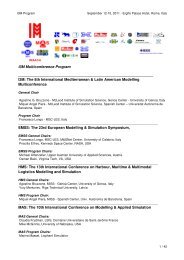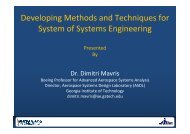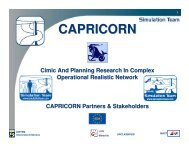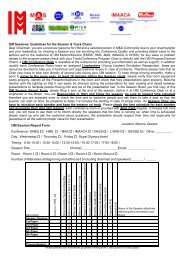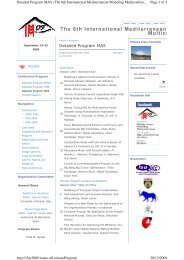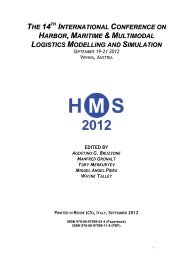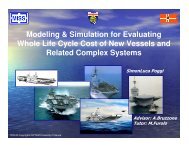HMS2006_F1 - Liophant Simulation
HMS2006_F1 - Liophant Simulation
HMS2006_F1 - Liophant Simulation
You also want an ePaper? Increase the reach of your titles
YUMPU automatically turns print PDFs into web optimized ePapers that Google loves.
Usage percentage Current situation Scenario 1 Scenario 2<br />
Gantry crane 47% * 74% ±1% 87% ±2%<br />
Reachstacker 1 63% ±5% 84% ±4% 89% ±3%<br />
Reachstacker 2 63% ±6% 83% ±4% 89% ±3%<br />
Labour 1 66% ±5% 86% ±3% 87% ±6%<br />
Labour 2 59% ±6% 82% ±4% 85% ±2%<br />
Labour 3 47% 75% ±1% 85% ±2%<br />
Tracks 100% 100% 100%<br />
Table 1. Efficiency indicators<br />
Indicator Current situation Scenario 1 Scenario 2<br />
Avg. num. of 40-feet cont. in the storage area 529 ±11 602 ±12 629 ±33<br />
Avg, waiting time in the storage area (min.) 5610 ±30 5040 ±10 3600 ±66<br />
Unattended trains 0 0 7<br />
Avg time in the storage area (including urgent ones)<br />
(min.)<br />
5300 ±30 4800 ±10 3600 ±57<br />
Table 2. Effectiveness indicators<br />
As an overall conclusion with regard to the<br />
computational results, the dry port is expected<br />
to meet the demand both in the short and the<br />
medium term. Were there more containers<br />
available the system could offer a higher level<br />
of quality service, although this decision is<br />
beyond the dry port managers’ responsibility.<br />
Besides, in the current operating conditions and<br />
working on a 24 hour/day basis, if the demand<br />
reached its maximum potential value, there<br />
would be some shortage of resources and some<br />
trains would not be attended. In case the<br />
managers desired to overcome this<br />
ineffectiveness operating as the dry port does<br />
now, it would be necessary to acquire some<br />
additional assets, to the detriment of the<br />
efficiency (since a higher lever of idleness<br />
would be expected).<br />
6. Conclusions<br />
An example of a simulation study to carry on a<br />
quantitative analysis of the performance of a<br />
intermodal terminal of a particular nature (a dry<br />
port) has been presented. The same<br />
methodology applied to similar studies has<br />
been successfully used, introducing the<br />
appropriate modifications to represent the<br />
particularities of the system at study. Besides<br />
some improvements have been included, being<br />
the variability of the train length (between a<br />
lower and an upper bound) and the more<br />
accurate representation of the<br />
loading/unloading processes by means of using<br />
a gantry crane.<br />
The model, verified and validated, has allowed<br />
the prediction of its performance in two<br />
plausible scenarios, and asses this performance<br />
in terms of quality service and resource<br />
utilisation.<br />
Acknowledgements<br />
The authors would like to thank the dry port<br />
managers for their attention and their time,<br />
which provided with accurate and valuable<br />
data, facilitating the success of the study.<br />
References<br />
• Gambardella, L. M. y Rizzoli, A. E. (2000).<br />
The role of simulation and optimisation in<br />
intermodal container terminals. Proceedings<br />
of ESS2000 12 th European <strong>Simulation</strong><br />
Symposium and Exhibition, pp. 422-6.



